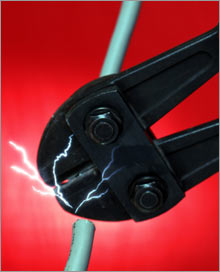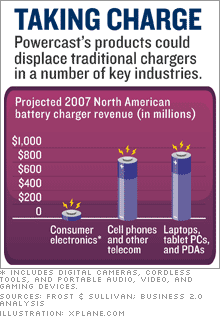 Death of the cell phone charger: a Pennsylvania entrepreneur has developed technology that gives you all the battery juice you need directly from the air.
Death of the cell phone charger: a Pennsylvania entrepreneur has developed technology that gives you all the battery juice you need directly from the air.
[From CNNMoney.com/Business2.0 Magazine:]
How much money could you make from a technology that replaces electrical wires? A startup called Powercast, along with the more than 100 companies that have inked agreements with it, is about to start finding out. Powercast and its first major partner, electronics giant Philips, are set to launch their first device powered by electricity broadcast through the air.
It may sound futuristic, but Powercast's platform uses nothing more complex than a radio--and is cheap enough for just about any company to incorporate into a product. A transmitter plugs into the wall, and a dime-size receiver (the real innovation, costing about $5 to make) can be embedded into any low-voltage device. The receiver turns radio waves into DC electricity, recharging the device's battery at a distance of up to 3 feet.  Picture your cell phone charging up the second you sit down at your desk, and you start to get a sense of the opportunity. How big can it get? "The sky's the limit," says John Shearer, Powercast's founder and CEO. He estimates shipping "many millions of units" by the end of 2008.
Picture your cell phone charging up the second you sit down at your desk, and you start to get a sense of the opportunity. How big can it get? "The sky's the limit," says John Shearer, Powercast's founder and CEO. He estimates shipping "many millions of units" by the end of 2008.
For years, electricity experts said this kind of thing couldn't be done. "If you had asked me seven months ago if this was possible, I would have said, 'Are you dreaming? Have you been smoking something?'" says Govi Rao, vice president and general manager of solid-state lighting at Philips. "But to see it work is just amazing. It could revolutionize what we know about power."
So impressed was Rao after witnessing Powercast's demo last summer that he walked away jotting down a list of the industries to which the technology could immediately be applied: lighting, peripherals, all kinds of handheld electronics. Philips partnered with Powercast last July, and their first joint product, a wirelessly powered LED light stick, will hit the market this year. Computer peripherals, such as a wireless keyboard and mouse, will follow in 2008.
Broadcasting power through the air isn't a new idea. Researchers have experimented with capturing the radiation in radio frequency at high power but had difficulty capturing it at consumer-friendly low power. "You'd have energy bouncing off the walls and arriving in a wide range of voltages," says Zoya Popovic, an electrical engineering professor at the University of Colorado who works on wireless electricity projects for the U.S. military.
That's where Shearer came in. A former physicist based in Pittsburgh, he and his team spent four years poring over wireless electricity research in a lab hidden behind his family's coffee house. He figured much of the energy bouncing off walls could be captured. All you had to do was build a receiver that could act like a radio tuned to many frequencies at once.
"I realized we wanted to grab that static and harness it," Shearer says. "It's all energy."
So the Powercast team set about creating and patenting that receiver. Its tiny but hyperefficient receiving circuits can adjust to variations in load and field strength while maintaining a constant DC voltage. Thanks to the fact that it transmits only safe low wattages, the Powercast system quickly won FCC approval--and $10 million from private investors. Powercast says it has signed nondisclosure agreements to develop products with more than 100 companies, including major manufacturers of cell phones, MP3 players, automotive parts, temperature sensors, hearing aids, and medical implants.
Powercast says it has signed nondisclosure agreements to develop products with more than 100 companies, including major manufacturers of cell phones, MP3 players, automotive parts, temperature sensors, hearing aids, and medical implants.
The last of those alone could be a multibillion-dollar market: Pacemakers, defibrillators, and the like require surgery to replace dead batteries. But with a built-in Powercast receiver, those batteries could last a lifetime.
"Everyone's looking to cut that last cord," says Alex Slawsby, a consultant at Innosight who specializes in disruptive innovation. "Think of the billion cell phones sold last year. If you could get Powercast into a small percentage of the high-end models, those would be huge numbers."
Could Powercast's technology also work for larger devices? Perhaps, but not quite yet. Laptop computers, for example, use more than 10 times the wattage of Powercast transmissions.
But industry trends are on Shearer's side: Thanks to less energy-hungry LCD screens and processors, PC power consumption is slowly diminishing. Within five years, Shearer says, laptops will be down to single-digit wattage--making his revenue potential even more electrifying.
Now this is pretty innovative. I've heard of people working on wireless solutions for bulk power transmission to replace power lines, but with little success (while theoretically possible, it's too difficult to wirelessly transmit high enough wattages safely, if I understand the hurdles correctly). This solution for small wattages over short distances seems like a good application of this kind of technology though.
There's a video of the Powercast technology on display at the CES 2007 conference back in January from CNET here. (And no, this isn't an April Fool's day joke!)
[Image credits: CNNMoney.com.]
[A hat tip to Jenny]
Sunday, April 01, 2007
Cut The Cord - Powercast Technology Transmitts Electricity Through the Air
Posted by
Jesse Jenkins
Ads at www.WattHead.org:
Wind Turbine Training
Solar Panels and Kits for the Home
Solar Energy Products and Home Solar Panels
Wind Turbine Training
Solar Panels and Kits for the Home
Solar Energy Products and Home Solar Panels
Subscribe to:
Post Comments (Atom)













3 comments:
This is great! Can't wait to see this for vehicles. Wireless charging stations! Woohoo!
The big question is whether this is a step forward or just another energy wasting convenience. I would guess this is considerably less efficient than plugging a charger directly to the device.
Hmmmm, Posted April 1....
Maybe Tesla was right, or maybe someone's having a good laugh. I'm hoping it will help dissolve some of the grid's capillaries.
Post a Comment